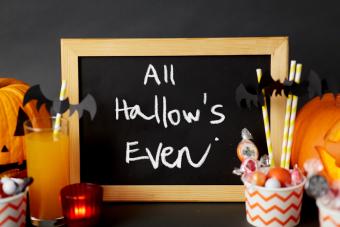
Why do we celebrate Halloween? The origins of Halloween go back thousands of years to Celtic Ireland, evolving through Christianity and Irish immigration to America. It has kept many of its original themes and traditions, including acknowledging spirits, wearing disguises, and exchanging treats. Explore the history of Halloween and learn how it became the spooky holiday many people cherish today.
Where Did Halloween Come From?
Halloween often brings imagery of ghouls and ghosts, which is not too far off from its origins. The history of Halloween begins with the Pagan festival of Samhain, beginning approximately 2,500 years ago. Samhain was an ancient Celtic celebration held from October 31st to November 1st. Though it is unknown exactly when Samhain began, the Celts are said to have existed dating back to 700 B.C. - though it's possible Samhain was celebrated even before their existence.

Samhain Beliefs and Festivities
Also known as the Celtic Day of the Dead, Samhain was believed to be a time when the supernatural could interact with the living world. The Celts would celebrate with harvests and feasts and would dress in animal skins to disguise themselves from harmful spirits (and maybe to play some mischievous tricks). Some 500 years later, this practice transformed into mumming, or the practice of children dressing up like scary creatures and performing in exchange for food and drink.
Halloween's Christian History
Samhain was celebrated for another several hundred years until Catholicism arrived and "Christianized" it. By the 8th Century, Pope Gregory III declared November 1st as All Saints' Day. This was a day to honor Christians who had died and gone to heaven. This was also referred to as All Hallows' Day (hallow meaning a holy person), therefore designating October 31st as All Hallows' Eve. In 1000 B.C., All Souls' Day was instated to commemorate all souls, including those in purgatory.
Christian Adaptations of Samhain Traditions
Allhallowtide, which included All Hallows' Eve, All Saints' Day, and All Souls' Day, became a time to honor the dead. Souling, or visiting doors to ask for soul cakes, had become a regular tradition and would occur on any of these three nights. This tradition was likely derived from Samhain, as well. By the 16th Century, Christianity had adopted many of the traditions of the pagan festival of Samhain throughout Allhallowtide, including bonfires, souling, and celebrating the turning of the season. At some point in this era, the pagan tradition of carving turnips was transformed into the Irish myth of Stingy Jack, and the idea of the jack-o'-lantern was born.
The Christian traditions of Allhallowtide continued to develop in Ireland and England over the next few hundred years. All Hallows' Eve became known as Hallow-e'en, which was eventually shortened to Halloween.
All Hallows' Eve Comes to America
How did Halloween start gaining traction in America? When the Potato Famine struck Ireland in 1845, many Irish people migrated to America, bringing their Catholic celebrations of Halloween with them.
American Halloween Traditions
Over the next few decades, some key changes occurred that are important to Halloween's history. In America, the pumpkin was found to be perfect for carving jack-o'-lanterns. Harper's Weekly published the first official image of a jack-o'-lantern carved into a pumpkin in 1867. Souling had become a lesser part of Halloween over the next few decades and was replaced with general mischief, pranks, and vandalism. Instead of exchanging soul cakes with children for a song or performance, people would exchange snacks with children in order for them to not play tricks.
Taming the Mischief
In 1920, a small town in Minnesota called Anoka decided to hold a city-wide Halloween festival in hopes to entertain (and distract) youngsters and pranksters. A few cities followed suit, but it wasn't until the "Black Halloween" occurrence of 1933 that towns had really had enough. After that night of serious vandalism, adults knew something needed to be done, and the idea of trick-or-treating and Halloween events like Anoka's became commonplace.
Following the Great Depression in the 1950s, candy companies saw Halloween as a prime opportunity to make money by incorporating these sugary treats into trick-or-treating. Over the next few decades, candy became an integral part of this Halloween tradition and was eventually the only acceptable treat.
Modern-Day Halloween
Halloween celebrations are on the rise around the world. What does Halloween celebrate today? Though not everybody uses the holiday as a time to honor the dead, it does still serve as a reminder of the possibility of otherworldly spirits. It is a time when you can explore the things that scare you the most. Traditions like trick-or-treating and carving jack-o'-lanterns are a lot of fun, and they serve as modern examples of Halloween's rich history. Only you can decide how and why you celebrate Halloween. Now that you know the origins of All Hallows' Eve, maybe the spooky holiday will mean even more to you.







